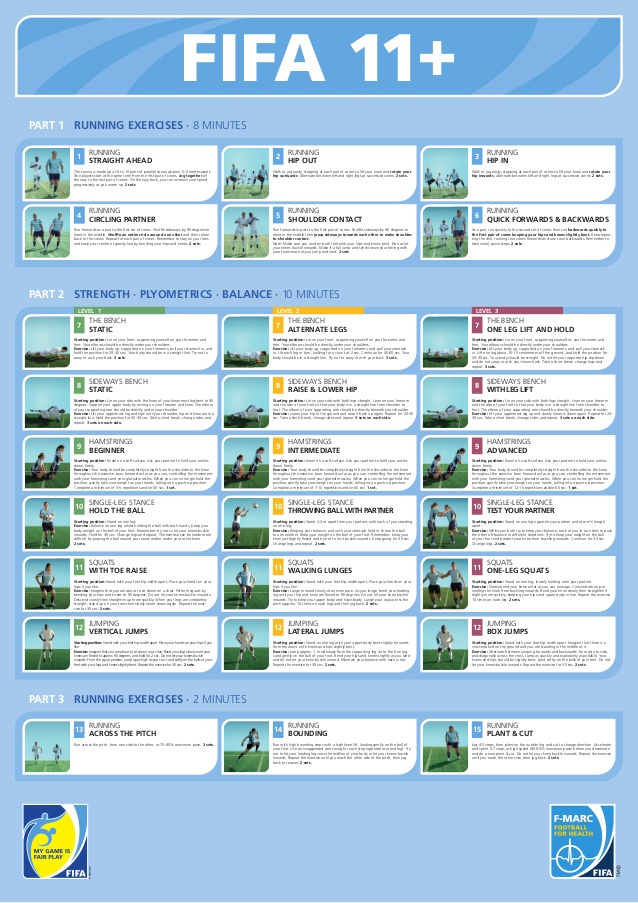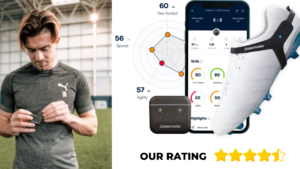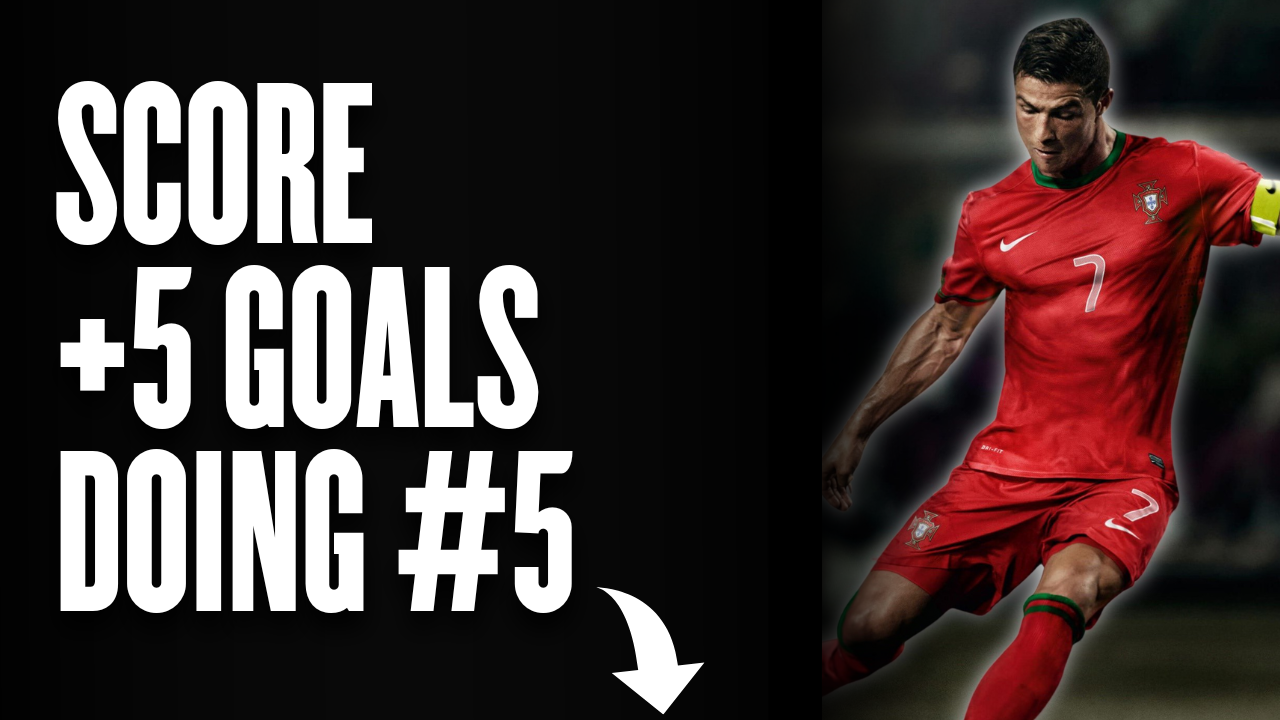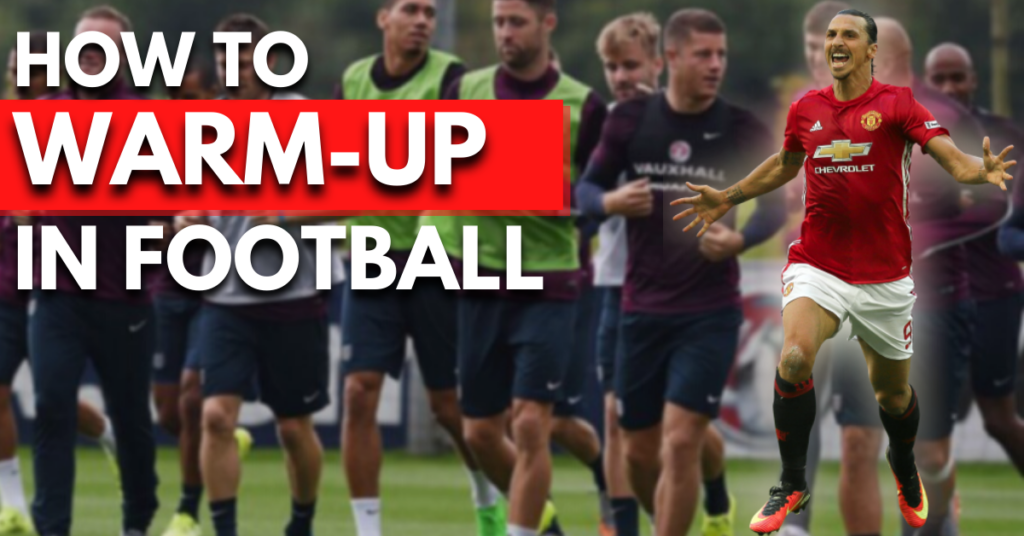
EVERY footballer finds a long warm-up boring (including myself!).
That is completely normal if one thinks that a footballer goes out there to play the actual game, not perform some random, boring moves, right?
A warm-up might be boring, but its importance is massive for performance, recovery, and injury risk reduction. But how can you warm up effectively?
Warming up for a football match or training session includes activities and exercises that gradually increase in intensity. A football warm-up should follow the RAMP protocol (Raise – Activate & Mobilise – Potentiate). Here are the contents of a typical football warm-up;
- Low-intensity running
- Dynamic stretching exercises
- Activation and mobilization exercises
- Sport-specific actions (i.e. changes of direction, jumps, dynamic running, accelerations, etc.)
- Drills with the ball (i.e. passing, ball control, dribbling, etc.)
WHY SHOULD A FOOTBALLER WARM-UP?
The use of appropriate warm-up protocols can lead to physiological changes, that will have a positive effect on a player’s physical and psychological performance and readiness, while significantly reducing the risk of injury [1]. All these warm-up effects can only come through the proper warm-up procedures. The objectives of a football-specific warm-up are;
- Increased body & muscle temperature
- Increased blood flow and heart rate
- Stimulation of the CNS (Central Nervous System)
- Increased joint ROM (Range of Motion)
- Appropriate muscle elasticity
- A smooth transition into high intensity, sport-specific actions
- Increased cognitive awareness and readiness
- Increased RFD (Rate of Force Development)
- Improved strength, speed, and power [2]
THE STRUCTURE OF A FOOTBALLER’S WARM-UP
Now that we’ve briefly mentioned the structure of a warm-up as well as its goals, we will continue by further analyzing the design of an effective warm-up.
For the needs of this analysis, we will use a protocol known as RAMP (Raise – Activate & Mobilize – Potentiate). [3]
Note here that an important element of a football warm-up is the intensity in each of these 3 phases. We start off from low-intensity actions (“Raise”) and transition into maximal effort, high-intensity, sport-specific actions (“Potentiation”) that reflect the conditions of the game or training session.
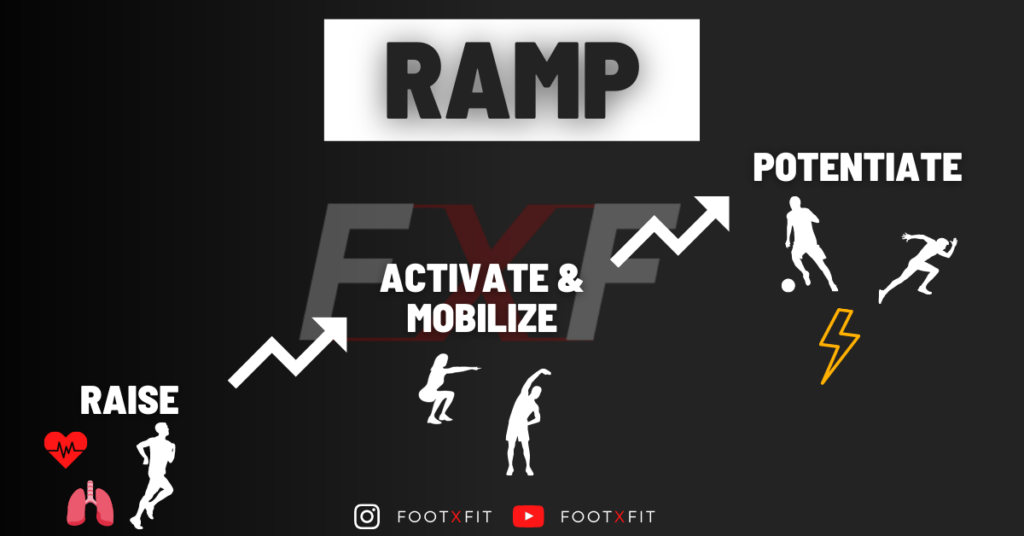
Warm-up/Phase # 1 – Raise
The first phase of the warm-up includes exercises and activities that will affect some of our physiological functions. These include increases in muscle and body temperature, as well as heart rate and subsequently blood flow. At the same time, the range of motion of the joints, especially of the lower extremities, begins to increase. The duration of the first warm-up phase usually does not exceed 5′ (3′-5′).
To achieve the above, you can use a variety of exercises and drills, either with or without a ball. Here are some suggestions:
- Low-intensity running
- Combination of low-intensity running and low-intensity, sport-specific actions
- Partner passing drills (1-2 combinations, pass to overlap, transition from 2m passing to 15m passing)
- Dribbling drills in limited spaces (free dribbling inside a square with changes of direction)
Warm-up/Phase #2 – Activate & Mobilize
In this warm-up phase, the goals include maintaining what was achieved in the first phase, while at the same time, seeking a greater motor unit activation and achieve an “ideal” range of motion of the joints.
At this stage, you can utilize different methods to achieve the new goals that we’ve set. Many times at training, where there is more time (and energy supplies), a player might as well use activation exercises. These exercises use either the footballer’s bodyweight or some small external resistance (light load, resistance bands, etc.).

*As an affiliate, I'm earning from qualifying purchases without any extra charges being placed on you.
Many footballers tend to perform these exercises before the start of the warm-up. Although not “bad”, it would be more “ideal” to “Raise” and then “Activate & Mobilize”.
It is also wise to mention the fact that this stage of the warm-up is superb for movement pattern work. Over the span of a full season, we can achieve great results and adaptations by including such work in our warm-up 1 to 3 times per week.
Here are some ways you can activate and mobilize;
- Dynamic stretching (sport-specific)
- Activation exercises with body weight (squats, side lunges, planks, Sumo walks, lateral bounds with stick landing)
- Activation exercises with resistance bands (side walks, hip raises, instep kicks)
- Exercises/Movements at a moderate-intensity (long stride/power runs, changes of direction or agility drills, lateral bounds, linear bounds)
- Movement pattern exercises (landing, acceleration, change of direction mechanics)
Having mentioned all of these, you could also utilize a series of drills on the ball. Ideally, these are done in a team environment, inside a small space, like a high-paced possession game, which is quite usual in a match warm-up.
Such exercises allow for a better neuromuscular activation and link the player with the next warm-up phase (potentiation) quite smoothly.
Warm-up/Phase # 3 – Potentiate
In this phase, the post-activation potentiation method is used. The aim here is to achieve a greater level of activation in the neuromuscular system and transition into high-intensity game actions. At this stage of the warm-up, which also is the last one, maximum dynamic actions are required, usually without the ball.
The role of this phase is quite important since post-activation potentiation has been proven to be performance-enhancing. [4] The objective here is to transfer the player into game-mode.
In the potentiation phase, maximum efforts of the whole neuromuscular system are required. These include;
- Sprints at various distances (5m-25m)
- Changes of direction
- Agility/drills with reactionary components
- Plyometric exercises
- Combination of the above
Many of those exercises can also be combined with actions on the ball
- Shots to sprint with changes of direction (attacking players)
- Partner passing (1m-2m) for 5 ” to sprint (10m-20m) (midfield players)
- Long balls (x2-3 each player) to changes of direction and 5m sprint (defensive players)
Having analyzed the basic elements of a well-structured warm-up program for football, we will now look at a typical warm-up any footballer/football team can do.
FOOTBALL-SPECIFIC WARM-UP
Phase #1 – Raise

*As an affiliate, I'm earning from qualifying purchases without any extra charges being placed on you.
- Low-intensity jogging (1’)
- Partner passing (2’-3’)
Phase #2 – Activate & Mobilize
- Dynamic stretching (3’-4’)
- Activation exercises (Sumo Walks, Side Lunges, Shoulder Taps – 2’-3’)
- Power/Long Stride Runs X 1-2 reps
Phase #3 – Potentiate
- Short to moderate distance sprints (<15m) X 2
- Sprints with changes of direction X 2
- Side shuffles to a visual reaction to sprint (<10m) X 1
The potentiation phase usually take up about 2’.
THIS IS WHY YOUR WARM-UP IS POOR (MISTAKES)
Long, Boring, Energy-Consuming Warm-Ups
Many footballers and coaches make mistakes that significantly reduce the efficiency of their warm-up and consequently their performance. One of those mistakes is long warm-ups.
The player (and the team) has limited resources available (energy and time). Thus, a long warm-up can lead to higher energy costs while at the same time depriving time of the total duration of the training session. This time could be invested in the development process of various other performance areas. In addition, an extensive warm-up KILLS a player’s motivation as he/she realizes that time on the ball will most probably be limited.
Static Stretching – A Big “NO” For Warm-Ups In Football
Another mistake we see a lot is the use of static stretching. [2] More and more studies are coming to show that static stretching has counterproductive effects on football performance, and generally sports that are dependent on speed and strength. You can find more info on this topic in this article we wrote on static stretching (click here).
Warm-Ups & High Temperatures
As we’ve already said, the RAMP protocol as well as any other warm-up procedure leads to significant increases in a player’s body and muscle temperature, HR, and blood flow. However, extensive warm-up procedures in hot and humid climates can drain the player and result in a lower endurance ability and dehydration. [3]. Therefore, you should consider minimizing/eliminating the duration of the first phase and include water breaks to aid hydration, in case of warm weather conditions.
RE-WARMUP AT HALF-TIME
One area of game-day performance that is often getting overlooked by both the coaching staff and the players themselves is the warm-up for the start of the second half.
It is proven that an effective warm-up strategy applied at half-time can lead to a better team and individual performance, especially in the first 10′-15′. [2,5] The benefits are multiplied when the opposing team does not take any warm-up measures before the second half, giving you an edge over them.
Therefore, it is really important to invest somewhere between 3′ to 5′ before the second half to re-integrate yourself into the match.
Five minutes are more than enough to complete all the necessary re-warm-up actions. Those 5′ usually include some dynamic stretching of the lower body and core, as well as some potentiation exercises, such as short-distance sprints, quick changes of direction, and jumps.
Furthermore, it’s also of high importance to sustain a high muscle and body temperature during the half-time break. This can be achieved with high room temperatures and warm clothing gear/equipment.
More information on how you can take advantage of your half time can be found here.
CONCLUSION
An efficient warm-up makes up the base of your performance, recovery, and injury risk reduction. With an overflow of information out there, players and coaches might often times get confused about what is right and wrong. To sum up this topic, we would like to once again outline the basic principles, that will help anyone structure a warm-up efficiently.
First, you need to make sure that your warm-up is specific to your sport. In your case, the aim is to involve joint angles, movements, and actions you perform inside the actual game of football (kicks, jumps, changes of speed, changes of direction, etc).
In addition to that, your warm-up shouldn’t drown your energy (& time!) supplies. You only have limited capacities of these. Use them wisely so you can either maximize the results you get from training or achieve peak performance on game-day.
Lastly, you can always refer back to the RAMP protocol and select exercises/drills that suit the intensity of your warm-up phases and the movements you’re going to perform in your sport. I’d also highly suggest you take a look at the FIFA 11+ warm-up protocol. A well-researched and effective warm-up strategy anyone can use.
And always remember, keep it simple, stupid!
